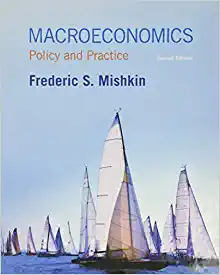Question
How did Classical economic theory affect US economic policy during the Great Depression? A) It advocated for aggressive spending because of its belief in Keynesian
How did Classical economic theory affect US economic policy during the Great Depression?
A) It advocated for aggressive spending because of its belief in Keynesian theory
B) It encouraged the Federal Reserve to manipulate interest rates
C) Its laissez-faire policy led US policy makers to adopt inactive fiscal and monetary policies
D) It encouraged a massive increase in the money supply
E) It argued governments should take on a larger role in investment practices
What is a reason why policy makers adopted Keynesian policies after World War II and through the 1960s?
A) The success of New Deal policies
B) Social Security, unemployment benefits, and other spending had had a positive impact on gross domestic product (GDP)
C) The Phillips Curve provided theoretical proof of the effectiveness of government activism
D) US government offices employed many economists who believed in Keynesian theory
E) All of the above
What is stagflation?
A) Inactive government spending
B) Simultaneous high unemployment and high inflation
C) Aggressive taxation on imports
D) A reduction in gross domestic product (GDP)
E) Inflation isolated equestrian industry
What macroeconomic trends in US economy caused high prices and high unemployment in the 1970s?
A) A reduction in aggregate supply and an increase in aggregate demand
B) Increased price competition due to foreign competition
C) A self-correction in numerous markets
D) Increases in the US money supply
E) An aging labor force
The "great debate" of the 1970s took place between what two groups of US economic thought?
A) Isolationists and expansionists
B) Democrats and Republicans
C) The Monetarists and the Neo-Keynesians
D) Classical economists and supply side economists
E) Monopolies and labor
How did the Laffer Curve support the theory of supply side economics?
A) By showing that competitive production could only be achieved by increasing taxes
B) By showing that lowering taxes could sometimes raise tax revenues
C) By endorsing the adoption of the gold standard
D) By showing it agreed with Neo-Keynesian economics
E) By arguing for increased labor rights
Why did monetarists hold monetary policy responsible for the severity of the Great Depression?
A) They believed that the Federal Reserve did too much
B) They believed monetary policy should have done more: increased the money supply or provided free loans to banks
C) The monetary rule directly led to the massive unemployment seen during the Great Depression
D) Advocates of monetary policy were too critical of fiscal policy, causing an impasse in which nothing was done.
E) They believe monetary policy should have followed the activist lead of fiscal policy during that time.
What was the name of the monetary policy Keynesian economists utilized in the 1960s in order to increase the money supply and keep interest rates as low as possible?
A) Bills only
B) Monetary rule
C) Quantity theory of money
D) Gold standard
E) Stocks only
What was the monetarist experiment?
A) Paul Volcker's attempt to curb inflation by minting new denominations of coin
B)The Federal Reserve's policy of keeping a strict limit to the growth of the money supply, no matter what interest rate levels were
C) Ronald Reagan's close adherence to the theories of Milton Friedman during his time in office
D) The Federal Reserve's attempt to mimic what had made the euro so successful
E) A synonym for supply side economics
How did Ronald Reagan's presidency appear to prove the rational expectations hypothesis?
A) He always told the truth, so the public knew exactly what to expect from economic policy
B) His ability to put confidence into the American people during times of economic hardship seemed to be more influential for policy effectiveness than the policies themselves
C) It didn't. Reagan's presidency stands as a reminder of how misguided the hypothesis is
D) His presidency showed how lowering taxes could improve gross domestic product (GDP) growth, and thus quality of life for everyone
E) By showing the US economy is best served by the executive branch of government
Step by Step Solution
There are 3 Steps involved in it
Step: 1

Get Instant Access to Expert-Tailored Solutions
See step-by-step solutions with expert insights and AI powered tools for academic success
Step: 2

Step: 3

Ace Your Homework with AI
Get the answers you need in no time with our AI-driven, step-by-step assistance
Get Started


